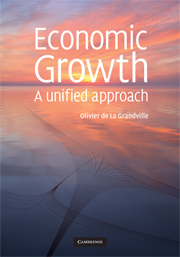Book contents
- Frontmatter
- Contents
- Introduction
- PART I POSITIVE GROWTH THEORY
- PART II OPTIMAL GROWTH THEORY
- 7 Optimal growth theory: an introduction to the calculus of variations
- 8 Other major tools for optimal growth theory: the Pontryagin maximum principle and the Dorfmanian
- 9 First applications to optimal growth
- 10 Optimal growth and the optimal savings rate
- PART III A UNIFIED APPROACH
- In conclusion: on the convergence of ideas and values through civilizations
- Further reading, data on growth and references
- Index
7 - Optimal growth theory: an introduction to the calculus of variations
Published online by Cambridge University Press: 01 February 2010
- Frontmatter
- Contents
- Introduction
- PART I POSITIVE GROWTH THEORY
- PART II OPTIMAL GROWTH THEORY
- 7 Optimal growth theory: an introduction to the calculus of variations
- 8 Other major tools for optimal growth theory: the Pontryagin maximum principle and the Dorfmanian
- 9 First applications to optimal growth
- 10 Optimal growth and the optimal savings rate
- PART III A UNIFIED APPROACH
- In conclusion: on the convergence of ideas and values through civilizations
- Further reading, data on growth and references
- Index
Summary
We know how an economy might behave under a number of hypotheses regarding the way factors of production are linked to output, and the way each of those factors are modified over time: labour through population growth; capital through investment. Also, technical progress can enter the picture in a number of different ways. Finally, the structure of the production function itself may be modified through time due to changes in the elasticity of substitution between capital and labour.
The question we now want to ask is the following: among all possible time paths that we might want to choose by setting a given investment policy, is one of those optimal in a sense to be defined? This question is at the heart of optimal growth theory, and has given rise to a huge volume of literature, sometimes controversial. We first have to determine the objective function, and for historical reasons which go back to Ramsey (1928), the objective supposedly defined by society is to maximize the sum, over a time span which may be finite or infinite, of discounted utility flows pertaining to consumption, given a production function constraint.
We will first give an example of such an objective; the example is voluntarily simplified in order for the reader to grasp easily the nature of the problem at stake.
- Type
- Chapter
- Information
- Economic GrowthA Unified Approach, pp. 177 - 198Publisher: Cambridge University PressPrint publication year: 2009



